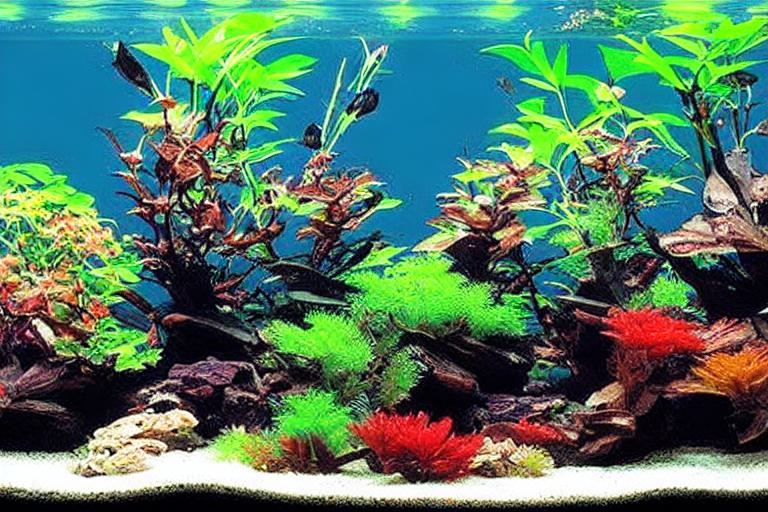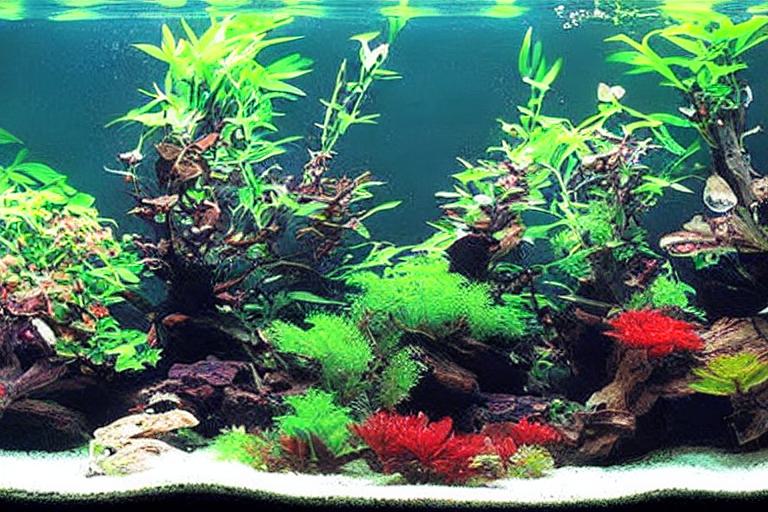If you have ever seen your fish scratching themselves on rocks or decorations in your aquarium, then you have likely witnessed ich, also known as white spot disease. Ich is a common freshwater fish disease caused by a single-celled parasite that can infect all fish, although some species are more resistant than others. Symptoms of ich include white spots on the skin, fins, and gills, as well as increased scratching, lethargy, and appetite loss. If left untreated, ich can be fatal to your fish.
The good news is that ich is relatively easy to treat, and there are a number of effective treatments available. In this article, we will discuss the best way to treat ich in your freshwater aquarium.
What is Ich
This parasite attaches itself to the fish’s skin and gills, causing irritation and inflammation. Ich is caused by a single-celled protozoan called Ichthyophthirius multifiliis. Ich, also known as white spot disease, is a common parasitic infection that can affect both freshwater and saltwater fish. Ich can be deadly to fish, especially if left untreated.
There are several methods of treating ich, but the most effective is to raise the water temperature to 86 degrees Fahrenheit for three days. Another treatment option is to add a medication to the water that is specifically designed to kill ich. This will cause the parasite to detach from the fish and die.
If you suspect that your fish have ich, it is important to act quickly. The sooner you begin treatment, the greater the chance your fish will recover.

Symptoms
The fish may also scratch themselves on objects in the tank, and they may have clamped fins. In severe cases, the fish may stop eating and become lethargic. Symptoms of ich include white spots on the fish, which are actually the parasite’s cysts.
Life Cycle
An aquarium ich life cycle has three stages: the infective theront stage, the replicating trophont stage, and the infective tomont stage. The theront stage is when the ich parasite is free-swimming and looking for a host. The tomont stage is when the ich parasite is ready to leave its host and find a new one. This is the replicating trophont stage. Once it finds a host, it attaches itself and begins to grow.
If you wait until the tomont stage, the ich parasite will be much harder to kill. This is when the ich parasite is most vulnerable. It is important to catch ich early, in the theront stage. Aquarium ich can be difficult to treat because of its life cycle.

Treating Ich
Ich, or ichthyophthirius multifiliis, is a parasitic infection that can cause your fish a great deal of stress and even death if left untreated. If your freshwater aquarium is home to fish, there’s a chance you’ll eventually have to deal with ich.
Fortunately, treating ich is relatively simple and can be done with a variety of over-the-counter medications. The most important thing is to act quickly as soon as you notice the first signs of ich, which include white spots on the fish’s body and fins.
This speeds up the life cycle of the parasites, causing them to fall off the fish before they can do any serious damage. If you catch ich early, you can often treat it simply by raising the temperature of the water in your aquarium.
If the temperature treatment doesn’t work, or if the ich has already caused your fish a great deal of stress, you’ll need to treat the water with a medication designed specifically for ich. There are a variety of these medications available, so be sure to ask your local fish store for a recommendation.
With quick treatment, ich can be easily controlled and your fish will be back to their happy, healthy selves in no time.

Raising water temperature
Ich is a common freshwater fish disease caused by a parasite. The parasite infects the fish’s skin and gills, causing irritation and heavy breathing. If left untreated, ich can be fatal. If you notice your fish scratching themselves or flashing, it is likely they have ich.
Once the temperature is raised, keep it there for two weeks. This will ensure all the parasites are gone. To treat ich, you will need to raise the water temperature. The higher temperature speeds up the parasite’s life cycle, causing it to fall off the fish more quickly. Raise the water temperature to 86 degrees Fahrenheit over the course of a week.
If you have live plants in your aquarium, raising the water temperature may cause them to die. To protect your plants, you can move them to a separate tank during treatment.
After two weeks, gradually lower the water temperature back to its normal level. Ich is now gone and your fish are healthy and happy!
Medicate your tank
Ich is a highly contagious disease that can quickly kill your fish if left untreated. If your fish are displaying any of the symptoms of Ich, it’s important to take action immediately.
The key is to choose the right medication for your particular situation and to follow the directions carefully. The good news is that Ich is relatively easy to treat, and there are a variety of effective medications available.
For larger tanks, you may need to use a medicated food or a dip. If you have a small tank, you may want to consider using a medication that can be added directly to the water.
Whatever method you choose, it’s important to treat all of the fish in your tank, even if only a few are showing symptoms. Ich is very contagious, and it’s only a matter of time before all of your fish are affected.
With prompt treatment, you can quickly get rid of Ich and protect your fish from this potentially deadly disease.
Using salt to treat Ich
If your freshwater aquarium is home to fish, there’s a chance you may eventually deal with ich. While ich is not usually fatal, it can cause your fish a great deal of stress and make them more susceptible to other illnesses. Ich, or white spot disease, is a common parasitic infection that can affect both freshwater and saltwater fish.
Dissolving salt in your aquarium water creates a brackish environment that is hostile to ich parasites. Fortunately, ich is relatively easy to treat with salt. You’ll need to add enough salt to raise the salinity of the water to around 1%, which is about 1/2 cup of salt per gallon of water.
Ich can also be difficult to eradicate completely, so it’s important to be patient and persistent with your treatment. Once the salt has been added, it’s important to monitor your fish closely. Some fish are more sensitive to salt than others, and you may need to make adjustments to the amount of salt you’re using.
Empty your tank for 4 days
If you have ich in your freshwater aquarium, one of the best things you can do is to empty your tank for four days. This will allow you to treat the ich without harming your fish.
Be sure to clean the tank thoroughly before adding fresh water. To empty your tank, remove all of the water and all of the fish.
Be sure to follow the directions on the product label. During the four days that your tank is empty, treat the ich with a product that is safe for use in freshwater aquariums.
After four days, you can add fresh water to your tank and add your fish back in. Your fish will be safe and the ich will be gone.
Watch for other infections
As your fish become sick with one disease, they become more susceptible to other infections. This is because their immune system is already weakened, making it easier for other diseases to take hold.
Some of the most common infections that can occur alongside ich are bacterial infections and fungal infections. These can be difficult to treat, so it’s important to be on the lookout for early signs.
Bacterial infections often cause the fish to develop red or white patches on their skin. They may also have trouble breathing, and their fins may become frayed.
These spots may be fuzzy or raised, and they may spread to the fins and gills. Fungal infections often cause the fish to develop white spots on their skin.
If you notice any of these signs, it’s important to take your fish to the vet for a diagnosis and treatment plan. With early intervention, you can help your fish recover and prevent further infections.
Preventing Ich
Preventing ich in your freshwater aquarium is fast and effective with the right treatment. There are a few key things to remember when treating ich:
Quarantine new fish before adding them to your main tank. This will help to prevent the spread of disease. 1.
A clean tank is less likely to harbor disease-causing bacteria. 2. Keep your tank clean and free of debris.
If you see any fish with white spots on their body, fins, or tail, this is a sign of ich. 3. Inspect your fish regularly for signs of illness.
There are many effective treatments available, so be sure to choose one that is right for your fish. 4. Treat ich immediately with a quality ich treatment.
Following these simple tips will help to keep your fish healthy and ich-free.
To conclude
By following the advice in this article, you can quickly and effectively treat ich in your aquarium. To conclude, ich is a common freshwater fish disease that can be easily treated with a few simple steps.
Frequently Asked Questions
1. What is ich?
Ich, or ichthyophthirius multifiliis, is a freshwater fish parasite that can infect both wild and captive fish. It is characterized by white spots on the fish’s body, fins, and gills.
2. How does ich spread?
Ich is spread through direct contact with infected fish, or through contaminated water. It can also be spread by using infected fish tanks or equipment.
3. How do I know if my fish has ich?
The most common symptom of ich is the presence of white spots on the fish’s body, fins, and gills. Other symptoms include lethargy, loss of appetite, and increased respiratory rate.
4. How do I treat ich?
There are a number of effective treatments for ich, including both chemical and non-chemical options. Some of the most common treatments include raising the water temperature, adding salt to the water, and using ich-killing medications.
5. How can I prevent ich?
The best way to prevent ich is to quarantine new fish before adding them to your main tank. This will allow you to treat any potential infections before they have a chance to spread. You should also regularly clean your tanks and equipment, and avoid overstocking your aquarium.
Final thoughts
If you have ich in your freshwater aquarium, there are a few things you can do to get rid of it. First, you can raise the temperature of the water. Second, you can add salt to the water. Third, you can use a commercial ich treatment. Fourth, you can remove the fish from the aquarium and treat them in a hospital tank.
Ich is a common problem in freshwater aquariums, but it can be treated quickly and effectively with a little effort.
